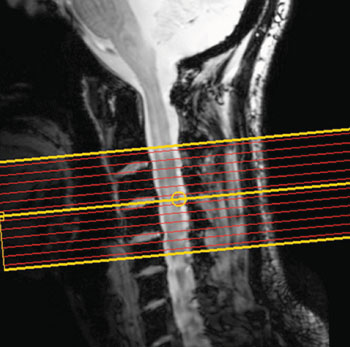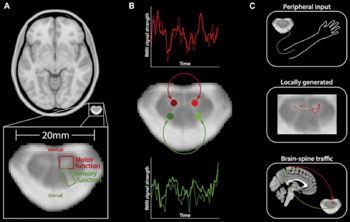Ultrahigh-Field fMRI Findings May Help Patients Recover from Spinal Cord Injury
|
By MedImaging International staff writers Posted on 19 Aug 2014 |

Image: The levels of activity in different parts of the spinal cord of resting individuals were measured using fMRI (Photo courtesy of Barry RL, Smith SA, Dula AN, et al, eLIfe journal, August 5, 2014).

Image: Resting-state signals in the human spinal cord. (A) Horizontal section of a brain (top) and a spinal cord (middle, bottom); the small size of the spinal cord makes it difficult to image neuronal activity. The spinal cord contains two ventral horns (one outlined in red) that are involved in motor function, and two dorsal horns (one outlined in green) that are involved in sensory function. (B) Barry et al. measured the correlation between spontaneous fluctuations in the fMRI signal in the ventral horns (red traces; top) and the dorsal horns (green traces; bottom). This revealed that the ventral horns show a positive correlation with each other, as do the dorsal horns. However, there is no significant correlation between ventral and dorsal horns. This suggests that at rest, the spinal cord is intrinsically organized into two separate networks, corresponding to motor and sensory functions. (C) Possible mechanisms that could explain the spontaneous activity in the spinal cord include input from the peripheral nervous system (top), locally generated rhythms from the interneurons within spinal networks (middle), and ongoing communication between the brain and spinal cord (bottom) (Photo courtesy of Barry RL, Smith SA, Dula AN, et al, eLIfe journal, August 5, 2014).
Researchers have achieved the first validated noninvasive measurement of neural signaling in the spinal cords of healthy human volunteers. Their imaging technology may aid efforts to help patients recover from spinal cord injuries and other disorders affecting spinal cord function, including multiple sclerosis.
“We definitely hope that this work can be translated to address many neurological disorders,” said the study’s first author, Robert Barry, PhD, a postdoctoral research fellow in the Vanderbilt University Institute of Imaging Science (VUIIS; Nashville, TN, USA). Directed by senior author John Gore, PhD the study’s findings were published on August 5, 2014, in the journal eLife.
The researchers used ultrahigh-field functional magnetic resonance imaging (fMRI) to detect for the first time “resting state” signals between neural circuits in the human spinal column. These signals are continuously active, not in response to external stimuli. “We see these background resting circuits as being inherent measures of function,” said Dr. Gore, a professor of medicine, university professor and vice chair of research in the department of radiology and radiological sciences.
The imaging findings may help provide insights into how spinal cord injury alters the “functional connectivity” between neural circuits, for example, and for evaluating and tracking recovery that occurs spontaneously or following various interventions. “The hope is that when you have impaired function that there will be changes [in the signals],” Dr. Gore said. “We’ve already got evidence for that from other studies.”
Research into the “resting” brain reveals how neural circuits coordinate to control various functions and to generate different behaviors. The spinal cord has been more complicated to study because it is much smaller than the brain, and traditional fMRI is not sensitive enough to capture its signals.
The Vanderbilt researchers overcame this hurdle by using an fMRI scanner with a 7 Tesla magnet, multichannel spinal cord coils, and cutting-edge technology for acquiring and analyzing the images.
Related Links:
Vanderbilt University Institute of Imaging Science
“We definitely hope that this work can be translated to address many neurological disorders,” said the study’s first author, Robert Barry, PhD, a postdoctoral research fellow in the Vanderbilt University Institute of Imaging Science (VUIIS; Nashville, TN, USA). Directed by senior author John Gore, PhD the study’s findings were published on August 5, 2014, in the journal eLife.
The researchers used ultrahigh-field functional magnetic resonance imaging (fMRI) to detect for the first time “resting state” signals between neural circuits in the human spinal column. These signals are continuously active, not in response to external stimuli. “We see these background resting circuits as being inherent measures of function,” said Dr. Gore, a professor of medicine, university professor and vice chair of research in the department of radiology and radiological sciences.
The imaging findings may help provide insights into how spinal cord injury alters the “functional connectivity” between neural circuits, for example, and for evaluating and tracking recovery that occurs spontaneously or following various interventions. “The hope is that when you have impaired function that there will be changes [in the signals],” Dr. Gore said. “We’ve already got evidence for that from other studies.”
Research into the “resting” brain reveals how neural circuits coordinate to control various functions and to generate different behaviors. The spinal cord has been more complicated to study because it is much smaller than the brain, and traditional fMRI is not sensitive enough to capture its signals.
The Vanderbilt researchers overcame this hurdle by using an fMRI scanner with a 7 Tesla magnet, multichannel spinal cord coils, and cutting-edge technology for acquiring and analyzing the images.
Related Links:
Vanderbilt University Institute of Imaging Science
Latest MRI News
- Low-Cost Whole-Body MRI Device Combined with AI Generates High-Quality Results
- World's First Whole-Body Ultra-High Field MRI Officially Comes To Market
- World's First Sensor Detects Errors in MRI Scans Using Laser Light and Gas
- Diamond Dust Could Offer New Contrast Agent Option for Future MRI Scans
- Combining MRI with PSA Testing Improves Clinical Outcomes for Prostate Cancer Patients
- PET/MRI Improves Diagnostic Accuracy for Prostate Cancer Patients
- Next Generation MR-Guided Focused Ultrasound Ushers In Future of Incisionless Neurosurgery
- Two-Part MRI Scan Detects Prostate Cancer More Quickly without Compromising Diagnostic Quality
- World’s Most Powerful MRI Machine Images Living Brain with Unrivaled Clarity
- New Whole-Body Imaging Technology Makes It Possible to View Inflammation on MRI Scan
- Combining Prostate MRI with Blood Test Can Avoid Unnecessary Prostate Biopsies
- New Treatment Combines MRI and Ultrasound to Control Prostate Cancer without Serious Side Effects
- MRI Improves Diagnosis and Treatment of Prostate Cancer
- Combined PET-MRI Scan Improves Treatment for Early Breast Cancer Patients
- 4D MRI Could Improve Clinical Assessment of Heart Blood Flow Abnormalities
- MRI-Guided Focused Ultrasound Therapy Shows Promise in Treating Prostate Cancer
Channels
Radiography
view channel
Novel Breast Imaging System Proves As Effective As Mammography
Breast cancer remains the most frequently diagnosed cancer among women. It is projected that one in eight women will be diagnosed with breast cancer during her lifetime, and one in 42 women who turn 50... Read more
AI Assistance Improves Breast-Cancer Screening by Reducing False Positives
Radiologists typically detect one case of cancer for every 200 mammograms reviewed. However, these evaluations often result in false positives, leading to unnecessary patient recalls for additional testing,... Read moreUltrasound
view channel
First AI-Powered POC Ultrasound Diagnostic Solution Helps Prioritize Cases Based On Severity
Ultrasound scans are essential for identifying and diagnosing various medical conditions, but often, patients must wait weeks or months for results due to a shortage of qualified medical professionals... Read more
Largest Model Trained On Echocardiography Images Assesses Heart Structure and Function
Foundation models represent an exciting frontier in generative artificial intelligence (AI), yet many lack the specialized medical data needed to make them applicable in healthcare settings.... Read more.jpg)
Groundbreaking Technology Enables Precise, Automatic Measurement of Peripheral Blood Vessels
The current standard of care of using angiographic information is often inadequate for accurately assessing vessel size in the estimated 20 million people in the U.S. who suffer from peripheral vascular disease.... Read moreNuclear Medicine
view channelNew PET Agent Rapidly and Accurately Visualizes Lesions in Clear Cell Renal Cell Carcinoma Patients
Clear cell renal cell cancer (ccRCC) represents 70-80% of renal cell carcinoma cases. While localized disease can be effectively treated with surgery and ablative therapies, one-third of patients either... Read more
New Imaging Technique Monitors Inflammation Disorders without Radiation Exposure
Imaging inflammation using traditional radiological techniques presents significant challenges, including radiation exposure, poor image quality, high costs, and invasive procedures. Now, new contrast... Read more
New SPECT/CT Technique Could Change Imaging Practices and Increase Patient Access
The development of lead-212 (212Pb)-PSMA–based targeted alpha therapy (TAT) is garnering significant interest in treating patients with metastatic castration-resistant prostate cancer. The imaging of 212Pb,... Read moreGeneral/Advanced Imaging
view channel
Radiation Therapy Computed Tomography Solution Boosts Imaging Accuracy
One of the most significant challenges in oncology care is disease complexity in terms of the variety of cancer types and the individualized presentation of each patient. This complexity necessitates a... Read more
PET Scans Reveal Hidden Inflammation in Multiple Sclerosis Patients
A key challenge for clinicians treating patients with multiple sclerosis (MS) is that after a certain amount of time, they continue to worsen even though their MRIs show no change. A new study has now... Read moreImaging IT
view channel
New Google Cloud Medical Imaging Suite Makes Imaging Healthcare Data More Accessible
Medical imaging is a critical tool used to diagnose patients, and there are billions of medical images scanned globally each year. Imaging data accounts for about 90% of all healthcare data1 and, until... Read more
Global AI in Medical Diagnostics Market to Be Driven by Demand for Image Recognition in Radiology
The global artificial intelligence (AI) in medical diagnostics market is expanding with early disease detection being one of its key applications and image recognition becoming a compelling consumer proposition... Read moreIndustry News
view channel
Hologic Acquires UK-Based Breast Surgical Guidance Company Endomagnetics Ltd.
Hologic, Inc. (Marlborough, MA, USA) has entered into a definitive agreement to acquire Endomagnetics Ltd. (Cambridge, UK), a privately held developer of breast cancer surgery technologies, for approximately... Read more
Bayer and Google Partner on New AI Product for Radiologists
Medical imaging data comprises around 90% of all healthcare data, and it is a highly complex and rich clinical data modality and serves as a vital tool for diagnosing patients. Each year, billions of medical... Read more



















